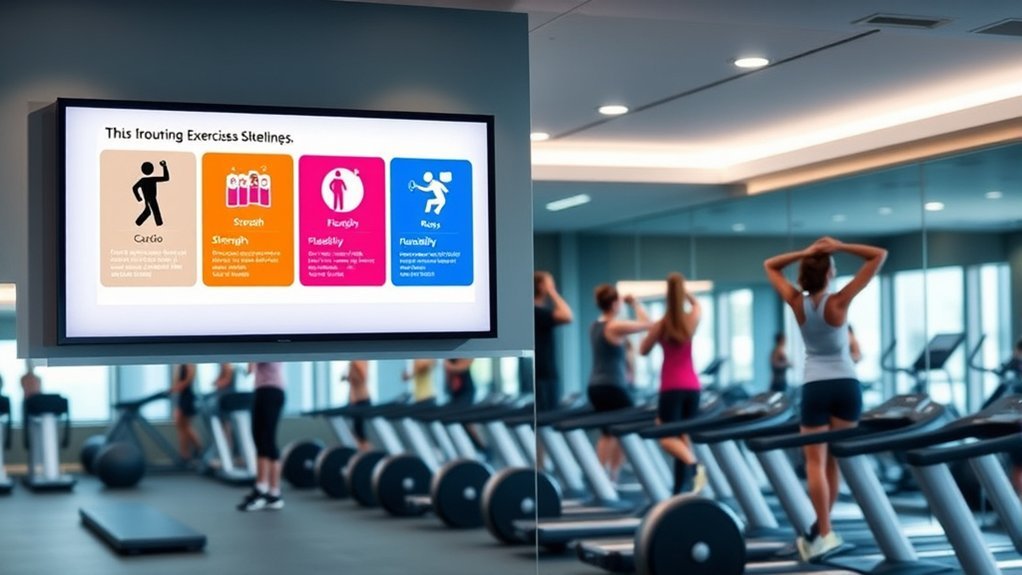When it comes to establishing an effective exercise routine, understanding your fitness goals is essential. You need to set clear, achievable objectives that guide your efforts. It’s not just about working out; it’s about creating a structured plan that balances frequency, intensity, and variety. By focusing on these key elements, you’ll lay the groundwork for a sustainable fitness journey. So, what should your first steps look like? Let’s explore the essentials.
Understanding Your Fitness Goals

When you set out to improve your fitness, understanding your goals is essential. Start by defining what you want to achieve. Are you aiming to lose weight, build muscle, or enhance endurance? Each goal requires a different approach, so clarity is key.
Next, consider setting SMART goals—Specific, Measurable, Achievable, Relevant, and Time-bound. This framework helps you track progress and stay motivated.
Once you’ve established your goals, create a plan that aligns with them. Consistency is vital, so choose activities you enjoy to make the journey enjoyable.
Frequency: How Often Should You Exercise?

How often should you exercise to achieve your fitness goals? Ideally, you should aim for at least 150 minutes of moderate aerobic activity or 75 minutes of vigorous activity each week. This can be broken down into manageable sessions—think 30 minutes a day, five times a week.
If you’re looking to build strength, incorporate resistance training at least two days per week. Consistency is key; it’s better to establish a routine that fits your lifestyle.
Don’t forget to listen to your body—rest days are essential for recovery and preventing injury. Ultimately, find a frequency that challenges you while keeping you motivated and engaged. This balance will set you on the path to success in your fitness journey.
Intensity: Finding the Right Balance

Finding the right intensity in your workouts is essential for maximizing results and avoiding burnout. You want to push yourself just enough to challenge your body, but not so hard that you risk injury or fatigue.
An effective way to gauge intensity is by using the Rate of Perceived Exertion (RPE) scale. Aim for a level where you can still hold a conversation but feel your heart rate elevate.
Incorporate intervals—short bursts of high intensity followed by lower intensity periods—to boost your overall fitness and keep things interesting.
Remember, consistency is key; it’s better to maintain a moderate intensity over time than to go all out and lose motivation.
Listen to your body and adjust as needed to find your sweet spot.
Types of Exercise: A Comprehensive Overview
Understanding the various types of exercise can greatly enhance your fitness journey, as each type offers unique benefits tailored to different goals.
Here’s a quick overview of the main categories:
- Aerobic Exercise: Think running, cycling, or swimming—activities that get your heart pumping and improve cardiovascular health.
- Strength Training: Picture lifting weights or using resistance bands to build muscle and increase metabolism.
- Flexibility and Balance: Envision yoga or Pilates, which enhance your range of motion and stability, reducing injury risk.
Building a Balanced Workout Plan
To create an effective workout plan, it’s essential to incorporate a variety of exercises that address your fitness goals, preferences, and lifestyle.
Start by determining your objectives, whether it’s building strength, improving endurance, or enhancing flexibility. Next, include a mix of cardiovascular activities, strength training, and flexibility exercises to guarantee a well-rounded approach.
Determine your fitness objectives and include a balanced mix of cardio, strength training, and flexibility exercises for optimal results.
Aim for at least 150 minutes of moderate aerobic activity each week, paired with two or more days of strength training targeting major muscle groups.
Don’t forget to add enjoyable activities to keep you motivated. Finally, schedule your workouts consistently, balancing intensity and duration to promote progress while preventing burnout.
With this balanced plan, you’ll be equipped to achieve your fitness aspirations effectively.
Listening to Your Body: Rest and Recovery
While pushing yourself during workouts is important, listening to your body is essential for achieving long-term fitness success. Your body gives you signals, and it’s vital to pay attention to them. Ignoring fatigue or pain can lead to injuries that set you back.
To guarantee effective rest and recovery, remember to:
- Schedule rest days: Allow your muscles time to repair and grow stronger.
- Stay hydrated: Proper hydration aids recovery and maintains your performance.
- Incorporate light activities: Engage in gentle stretching or yoga to promote blood flow without overexerting yourself.
Recognizing when to rest isn’t a weakness; it’s a smart strategy.
Prioritize recovery, and you’ll find yourself more resilient and ready to tackle your next workout.
Staying Motivated: Tips for Consistency
Staying motivated is essential for maintaining a consistent workout routine, and there are several effective strategies to keep you on track.
First, set specific, achievable goals that ignite your passion. Break these down into smaller milestones to celebrate your progress.
Next, find a workout buddy; exercising with someone else can boost your accountability and make it more enjoyable.
Finding a workout buddy can enhance your accountability and transform your fitness journey into a fun experience.
Incorporate variety into your routine to keep things fresh and exciting—experiment with different workouts or outdoor activities.
Establish a schedule that fits your lifestyle, and don’t be afraid to adjust it when needed.
Finally, remind yourself of the benefits you gain from exercising, whether it’s improved health, increased energy, or stress relief. Staying focused on your “why” will help you stay committed.
Tracking Progress: Measuring Your Success
Tracking your progress is a vital part of any fitness journey, as it helps you see how far you’ve come and keeps you motivated.
By measuring your achievements, you can make adjustments to your routine and stay on track. Here are some effective ways to track your success:
- Keep a workout journal: Document your workouts, noting weights, reps, and times.
- Use fitness apps: Track your activities and monitor your progress digitally, providing visual representations of your achievements.
- Take progress photos: Capture your physical changes over time, giving you a powerful visual reminder of your hard work.
Frequently Asked Questions
Can I Exercise While Recovering From an Injury?
Yes, you can exercise while recovering from an injury, but it’s essential to listen to your body. Focus on low-impact activities and consult your healthcare provider to guarantee you’re not hindering your recovery process.
What Should I Eat Before and After Workouts?
You can’t run on empty! Before workouts, grab a banana or some yogurt for energy. After, refuel with protein and carbs—think chicken and sweet potatoes. Your muscles will thank you while you bask in post-exercise glory!
How Do I Choose the Right Workout Clothes?
To choose the right workout clothes, focus on comfort, moisture-wicking fabrics, and fit. Opt for breathable materials, and make sure your gear allows for movement. Don’t forget to take into account the type of exercise you’ll be doing!
Is It Safe to Exercise During Pregnancy?
Yes, it’s generally safe to exercise during pregnancy, but you should consult your healthcare provider first. Focus on low-impact activities, listen to your body, and modify as needed to guarantee both you and your baby stay healthy.
Can I Exercise With Chronic Health Conditions?
Yes, you can exercise with chronic health conditions, but it’s essential to consult your healthcare provider first. They’ll help tailor a safe and effective exercise plan that suits your specific needs and health status.
Conclusion
So, as you commence on this fitness journey, remember: you’re not training for the Olympics—unless you are, in which case, good luck! Embrace the sweat, the sore muscles, and the occasional awkward gym moment like they’re your new best friends. Stay consistent, enjoy the process, and don’t forget to rest; even superheroes need a day off! You’ve got this—just keep moving, and soon enough, you’ll be flexing like a pro while wondering why you ever dreaded the gym in the first place!
